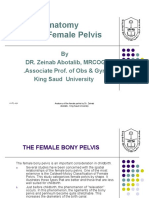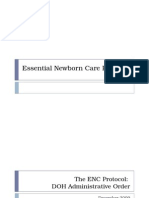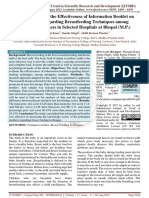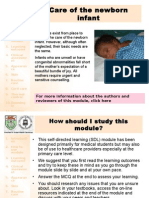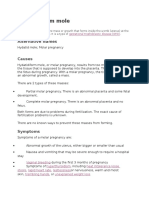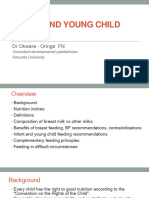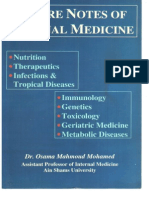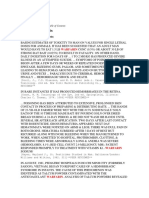Vit K
Vit K
Uploaded by
Kimbek BuangkeCopyright:
Available Formats
Vit K
Vit K
Uploaded by
Kimbek BuangkeOriginal Description:
Original Title
Copyright
Available Formats
Share this document
Did you find this document useful?
Is this content inappropriate?
Copyright:
Available Formats
Vit K
Vit K
Uploaded by
Kimbek BuangkeCopyright:
Available Formats
VITAMIN K
DEFICIENCY
HEMATOLOGY ONCOLOGY DIVISION
Introduction
The vitamin K :
K1: phytonadione or phylloquinone
(Aquamephyton): is a natural
derivative from fish or plants
K2: menaquinone: fat-soluble form
made by intestinal bacteria
K3: menadione: the synthetic
water-soluble form tends to have a
greater degree of toxicity
The recommended dietary allowance (RDA) for
vitamin K:
adult males: 80 mcg
adult females: 65 mcg
children 7 to 10 years: 30 mcg
infants: 10 mcg
pregnant and lactating women 65 mcg
Source
Leafy vegetables (spinach,
kale,collards, brocoli)
Pork
Liver
Vegetable oils (soybean oil,olive oil,
cottonseed oil, canola oil)
Intestinal flora
Synthesized by bacteria
Epidemiology
In adults, Vitamin K deficiency is
uncommon
In infants, Vitamin K deficiency without
bleeding may occur in as many as 50%
of infants younger than 5 days old
The classic haemorrhagic disease
:occurs in 0.25-1.7% of infants
The prevalence of late haemorrhagic
disease 20 per 100,000 live births with
no prior prophylaxis with Vitamin K
Risk Factors
Excessive anticoagulation with Coumarins, eg
Warfarin
Liver disease: e.g. cirrhosis, malignancy,
amyloidosis and Gauchers disease decrease the
synthesis of Vitamin K-dependent factors
Malabsorption: coeliac disease, tropical sprue,
Crohns disease, ulcerative colitis, Ascaris
infection, short bowel syndrome due to multiple
abdominal surgeries, bacterial overgrowth, and
chronic pancreatitis
Biliary tract disease: common duct obstruction
due to stones and strictures, primary biliasy
cirrhosis, cholangiocarcinoma, and chronic
cholestasis. Leads to a decrease in fat absorption
and so a deficiency of fat-soluble vitamins
Risk Factors
Dietary deficiency occurs in people with
malnutrition, including people with alcoholism,
as well as patients undergoing long-term
parenteral nutrition without Vitamin K
supplements.
Drugs: Cholestyramine, cefamandole,
salicylates, rifampin,isoniazid and barbiturates
are some of the common drugs that are
associated with Vitamin K deficiency.
Diseases with endogenously produced
coagulation inhibitors (e.g. lupus anticoagulant
and antithrombins) and paraproteinaemias such
as myeloma, may cause vitamin K deficiency.
Miscellaneous causes include massive
transfusion, DIC,polycythaemia vera, nephrotic
syndrome, cystic fibrosis and leukaemia
Vitamin K
Function
Involved in the formation of:
Prothrombin
(factor II)
Coagulation factors VII, IX, X
Factors dependent on Vitamin K
Protein
C, S (anticoagulants)
Protein Z
Bone matrix proteins
The deficiency syndrome is
traditionally known as haemorrhagic
disease of the newborn or more
recently, to give a better definition of
the cause, vitamin K deficiency
bleeding (VKDB)
Classification of vitamin K deficiency
bleeding of the newborn
Syndrome
Time of presentation Common bleeding
sites
Early VKDB
0-24 hours
Cephalohaematoma,
intracranial,
intrathoracic, intraabdominal
Classic VKDB
1-7 days
Gastrointestinal,
skin, nasal,
circumcision
Late VKDB
1-12 weeks
Intracranial, skin,
gastrointestinal
Early hemorrhagic disease of the
newborn :
The placenta transmits lipids and vitamin K
relatively poorly
The neonatal liver is immature with respect
to prothrombin synthesis
Breast milk is low in vitamin K, containing
about 2.5 g/L (cow's milk contains 5000
g/L)
The neonatal gut is sterile during the first
few days of life
Late hemorrhagic disease of the
newborn
Breastfeeding
Malabsorption
Liver disorder
Diagnosis
Lab findings
PT/PTT usually prolonged
Fibrinogen, platelet, bleeding time,
thrombin time normal
Vitamin K levels not usually helpful
Most sensitive indicator
des--carboxyprothrombin
(DCP)
PIVKA (Plasma Induced in Vitamin
K Abscence or Antagonism)
Management
Therapy depends on the severity of
the bleeding and the underlying cause
In life-threatening bleeds, Fresh
Frozen Plasma should be administered
prior to Vitamin K
Vitamin K is available as
phytomenadione (vitamin K) and as
the synthetic water-soluble analogue
menadiol sodium diphosphate
Management
Intravenous injections should be
given slowly as fast intravenous
injection can cause bronchospasm
and peripheral vascular collapse
Intramuscular injections may lead to
severe haematoma formation at the
injection site if clotting is impaired
Prognosis
Patients have a very good prognosis
if the Vitamin K deficiency is
recognized early and treated
appropriately
Morbidity correlates with severity of
Vitamin K deficiency, but severe
bleeding can be fatal
Prevention
Dosages for IM and Oral Vitamin K
The recommended route of
administration is intramuscular, being
given at birth, and that this should be
as a single IM injection:
Term babies 0.5-1mg IM soon after birth
Preterm 0.5mg IM soon after birth
Parents should be advised that with
intramuscular injection, the risk of
haemorrhagic disease of the newborn
is extremely low.
Prevention
If parents do not consent to IM but
consent to oral vitamin K, this needs
to be given in 3 separate doses
according to the following regime:
2mg oral soon after birth
2mg oral at 3-7 days
2mg oral at 6 weeks
You might also like
- MCN Board Exam QuestionsDocument14 pagesMCN Board Exam QuestionsStephannie Miranda100% (1)
- Neonatal SepsisDocument26 pagesNeonatal SepsisKimbek Buangke100% (1)
- Hematological Disorders of NewbornDocument98 pagesHematological Disorders of Newbornlieynna499650% (2)
- Neonatal Jaundice - 2019Document19 pagesNeonatal Jaundice - 2019floare de coltNo ratings yet
- Lecture On Defeciency DiseasesDocument52 pagesLecture On Defeciency Diseasesmanisha maniNo ratings yet
- Ed-Child Febrile FitDocument2 pagesEd-Child Febrile Fitmanish708345No ratings yet
- Profile of A NewbornDocument2 pagesProfile of A NewbornM.N MesaNo ratings yet
- Therapeutic PlayDocument9 pagesTherapeutic PlayVivek PrabhakarNo ratings yet
- Paediatrics - Febrile Convulsions Assessment, Treatment and Education PDFDocument12 pagesPaediatrics - Febrile Convulsions Assessment, Treatment and Education PDFPalash NagdeoteNo ratings yet
- Infectious Disease EpidemiologyDocument25 pagesInfectious Disease EpidemiologySaikat Datta100% (2)
- Diphtheria: By: Aguilloso, Shella Cano, Charnelle Jayne GDocument19 pagesDiphtheria: By: Aguilloso, Shella Cano, Charnelle Jayne Gjudith_carlosNo ratings yet
- APPENDIX A-Normal Values in HumansDocument22 pagesAPPENDIX A-Normal Values in HumansSultan AlexandruNo ratings yet
- Knowledge, Attitude and Practices Regarding Exclusive Breastfeeding Among Mothers Attending Maternal Child Health Clinic at Kitagata Hospital, Sheema District, UgandaDocument10 pagesKnowledge, Attitude and Practices Regarding Exclusive Breastfeeding Among Mothers Attending Maternal Child Health Clinic at Kitagata Hospital, Sheema District, UgandaKIU PUBLICATION AND EXTENSIONNo ratings yet
- Cleft Lip & Cleft Palate: Presentor Ms. Jeewan JyotiDocument25 pagesCleft Lip & Cleft Palate: Presentor Ms. Jeewan JyotiHamss AhmedNo ratings yet
- Promoting Nutritional Health During Pregnancy 19-20Document25 pagesPromoting Nutritional Health During Pregnancy 19-20Tony KhattarNo ratings yet
- Neonatal SeizuresDocument22 pagesNeonatal SeizuresKatrin Marcelina SihombingNo ratings yet
- Stage of Expulsion (2 Stage)Document36 pagesStage of Expulsion (2 Stage)Anonymous iG0DCOfNo ratings yet
- Drug Study Pharmacology in MidwiferyDocument3 pagesDrug Study Pharmacology in MidwiferyLeander Isabelle NoolNo ratings yet
- Pregnancy ChangesDocument20 pagesPregnancy ChangesMj BrionesNo ratings yet
- Lecture 1 Family PlanningDocument84 pagesLecture 1 Family PlanningAdistri KimNo ratings yet
- Anatomy of The Female Pelvis: by DR. Zeinab Abotalib, MRCOG Associate Prof. of Obs & Gyn - King Saud UniversityDocument24 pagesAnatomy of The Female Pelvis: by DR. Zeinab Abotalib, MRCOG Associate Prof. of Obs & Gyn - King Saud UniversityThrishia Jade IgotNo ratings yet
- Nursing TheoriesDocument67 pagesNursing TheoriesDrPreeti Thakur ChouhanNo ratings yet
- Pregnancy Discomforts and InterventionsDocument37 pagesPregnancy Discomforts and Interventionspppamm100% (3)
- Spina Bifida ModuleDocument5 pagesSpina Bifida ModuleJulliza Joy PandiNo ratings yet
- Essential Newborn Care ProtocolDocument30 pagesEssential Newborn Care ProtocolGwendareign ElizanNo ratings yet
- Febrile Convulsions in ChildrenDocument2 pagesFebrile Convulsions in ChildrenMagdalena Dwiyani HutajuluNo ratings yet
- Respiratory DisordersDocument6 pagesRespiratory DisordersSusan MaglaquiNo ratings yet
- Acute Renal FailureDocument30 pagesAcute Renal FailureJerinNo ratings yet
- Msn-Small Bowel Disorder - SeminarDocument71 pagesMsn-Small Bowel Disorder - SeminarSarithaRajeshNo ratings yet
- PediatrictraumaDocument41 pagesPediatrictraumaPriyaNo ratings yet
- DehydrationDocument27 pagesDehydrationDivika ShilvanaNo ratings yet
- Birthspacing and Family Planning in Pakistan - Nursing - Tutor's - FinalDocument247 pagesBirthspacing and Family Planning in Pakistan - Nursing - Tutor's - FinalCyril Baye100% (1)
- A Study To Assess The Effectiveness of Information Booklet On Knowledge Regarding Breastfeeding Techniques Among Primipara Mothers in Selected Hospitals at Bhopal M.P.Document8 pagesA Study To Assess The Effectiveness of Information Booklet On Knowledge Regarding Breastfeeding Techniques Among Primipara Mothers in Selected Hospitals at Bhopal M.P.Editor IJTSRDNo ratings yet
- Bladder Extrophy: Medical ManagementDocument8 pagesBladder Extrophy: Medical ManagementChristian James CamaongayNo ratings yet
- Colonic Irrigation - Children's Hospital of Pittsburgh of UPMCDocument3 pagesColonic Irrigation - Children's Hospital of Pittsburgh of UPMCWaNda GrNo ratings yet
- 1 RicketsDocument32 pages1 RicketsDarina Ismakaieva100% (1)
- Profile of The NewbornDocument5 pagesProfile of The NewbornNIKAH PAULINE ALCANTARANo ratings yet
- Care of The Newborn Infant: For More Information About The Authors and Reviewers of This Module, Click HereDocument30 pagesCare of The Newborn Infant: For More Information About The Authors and Reviewers of This Module, Click HereKeynethe JanineNo ratings yet
- LeukorrheaDocument29 pagesLeukorrheaThorsang Chayovan100% (1)
- Newborn AdaptationDocument13 pagesNewborn Adaptationrevathidadam55555No ratings yet
- Newborn Clinical QuizDocument5 pagesNewborn Clinical QuizAmy100% (1)
- Leprosy MsDocument78 pagesLeprosy MsAmit Kochhar67% (3)
- Suppositories: Presented byDocument21 pagesSuppositories: Presented byVanessa PatraoNo ratings yet
- AnaemiaDocument66 pagesAnaemiaSusmita DasNo ratings yet
- Passenger: (Fetus and Placenta)Document24 pagesPassenger: (Fetus and Placenta)Toni DomingoNo ratings yet
- Diagnosis of PregnancyDocument22 pagesDiagnosis of PregnancyvrutipatelNo ratings yet
- Iron Deficiency AnemiaDocument12 pagesIron Deficiency AnemiaFeraNoviantiNo ratings yet
- Neonatal Jaundice Clinical Practice GuidelineDocument35 pagesNeonatal Jaundice Clinical Practice GuidelineprinsepejesseNo ratings yet
- Immunization in New BornDocument5 pagesImmunization in New BornRose Lyn Camarista VelascoNo ratings yet
- Hydatidiform MoleDocument3 pagesHydatidiform MoleJny SherpaNo ratings yet
- Neonatal Seizures and Management: Dhaka Sishu Hospital BangladeshDocument19 pagesNeonatal Seizures and Management: Dhaka Sishu Hospital BangladeshGoha BashaNo ratings yet
- Ses 12 Principles of Newborn Adaption To The Extra-Uterine LifeDocument25 pagesSes 12 Principles of Newborn Adaption To The Extra-Uterine Lifelandegre KNo ratings yet
- Signs and Symptoms of DiseaseDocument3 pagesSigns and Symptoms of DiseaseAdrian MangahasNo ratings yet
- Management of Fever in ChildrenDocument1 pageManagement of Fever in ChildrensabirNo ratings yet
- Nutritional Composition of Breast MilkDocument24 pagesNutritional Composition of Breast MilkSamuel Bagas Wahyu SantosoNo ratings yet
- Infant and Young Child FeedingDocument90 pagesInfant and Young Child FeedingJoy KirumbaNo ratings yet
- Assessment - and - Management - of - Patients - With - Diabetes - Mellitus (1) FINALDocument80 pagesAssessment - and - Management - of - Patients - With - Diabetes - Mellitus (1) FINALAMIT MODWALNo ratings yet
- Abdominal Wall DefectsDocument20 pagesAbdominal Wall DefectsxylomiteNo ratings yet
- Intraventricular HaemorrhageDocument9 pagesIntraventricular HaemorrhageTriponiaNo ratings yet
- The Ideal Neutropenic Diet Cookbook; The Super Diet Guide To Replenish Overall Health For A Vibrant Lifestyle With Nourishing RecipesFrom EverandThe Ideal Neutropenic Diet Cookbook; The Super Diet Guide To Replenish Overall Health For A Vibrant Lifestyle With Nourishing RecipesNo ratings yet
- The Perfect Neutropenic Diet Cookbook; The Complete Nutrition Guide To Reinstating Overall Health For General Wellness With Delectable And Nourishing RecipesFrom EverandThe Perfect Neutropenic Diet Cookbook; The Complete Nutrition Guide To Reinstating Overall Health For General Wellness With Delectable And Nourishing RecipesNo ratings yet
- Vit KDocument22 pagesVit KKatrin Marcelina SihombingNo ratings yet
- Vitamin K Deficiency-3Document27 pagesVitamin K Deficiency-3Adeel ShahidNo ratings yet
- Thrombocytopenia: What We Will Cover TodayDocument23 pagesThrombocytopenia: What We Will Cover TodayKimbek BuangkeNo ratings yet
- Perioperative Management OF Brain Trauma: Tatang Bisri Konsultan Neuroanestesi IDSAIDocument52 pagesPerioperative Management OF Brain Trauma: Tatang Bisri Konsultan Neuroanestesi IDSAIKimbek BuangkeNo ratings yet
- Diarrhoea in PediatricsDocument89 pagesDiarrhoea in PediatricsKimbek BuangkeNo ratings yet
- SY Crafts Christmas Hats&Cloth&Socks Price ListDocument16 pagesSY Crafts Christmas Hats&Cloth&Socks Price ListKimbek BuangkeNo ratings yet
- IkterusDocument14 pagesIkterusAji KristiantoNo ratings yet
- Capacity (FVC) Pria Dewasa Denganoverweight: Pengaruh Latihan Aerobik Terhadap Forced VitalDocument6 pagesCapacity (FVC) Pria Dewasa Denganoverweight: Pengaruh Latihan Aerobik Terhadap Forced VitalKimbek BuangkeNo ratings yet
- Product Catalogue ANG B2b.indd MalyDocument42 pagesProduct Catalogue ANG B2b.indd MalyAlex NikolishviliNo ratings yet
- Vitamins: Pharmaceutical Chemistry - II (Biochemistry)Document30 pagesVitamins: Pharmaceutical Chemistry - II (Biochemistry)AyeshaNo ratings yet
- General Medicine Dr. Osama Mahmoud PDFDocument102 pagesGeneral Medicine Dr. Osama Mahmoud PDFRaouf Ra'fat Soliman100% (4)
- VKDBDocument11 pagesVKDBLucky PuspitasariNo ratings yet
- KBM 2Document27 pagesKBM 2Tisenda TimiselaNo ratings yet
- Micronutrient DeficienciesDocument71 pagesMicronutrient DeficienciesGelo Libelo100% (1)
- Drug StudyDocument8 pagesDrug StudyYaniiee DeFiestaNo ratings yet
- Hemorrhagic Disease of NewbornDocument13 pagesHemorrhagic Disease of NewbornRabi Dhakal100% (1)
- Nutrition DietaryDocument35 pagesNutrition DietaryAbdul Quyyum100% (2)
- VitaminsDocument4 pagesVitaminspearl042008No ratings yet
- Human Health Effects:: WarfarinDocument89 pagesHuman Health Effects:: WarfarinViviana Medranda PiscoNo ratings yet
- Fruits Amount Minerals Contained Vitamins ContainedDocument19 pagesFruits Amount Minerals Contained Vitamins ContainedDharmendra Singh LagoriyaNo ratings yet
- Lesson 1. Pediatric WardDocument9 pagesLesson 1. Pediatric WardFlonamae AbiarNo ratings yet
- RCOG - Obstetric CholestasisDocument14 pagesRCOG - Obstetric CholestasisSimon AhmadpourNo ratings yet
- Vitamin K 1Document8 pagesVitamin K 1Ganesh BichkuleNo ratings yet
- PDFDocument5 pagesPDFZyan MNo ratings yet
- UNIT 4 NOTES TILL 10thDocument44 pagesUNIT 4 NOTES TILL 10thPraveen SVNo ratings yet
- Interaksi Obat 1Document54 pagesInteraksi Obat 1Rada DoloksaribuNo ratings yet
- Vitamin K Deficiency in InfantsDocument7 pagesVitamin K Deficiency in InfantsCYNTHIANo ratings yet
- Proposal Chapter1 3 Moringa Leaves With Cucumber Ice Cream 11 2proposalDocument28 pagesProposal Chapter1 3 Moringa Leaves With Cucumber Ice Cream 11 2proposalRhed Tombaga100% (2)
- Coenzyme&CofactorDocument29 pagesCoenzyme&Cofactoranon_779975897No ratings yet
- Acenocoumarol Drug Information, ProfessionalDocument47 pagesAcenocoumarol Drug Information, ProfessionalMoisés PonceNo ratings yet
- Animal NutritionDocument111 pagesAnimal NutritionOliver TalipNo ratings yet
- Warfarin Patient"s HandbookDocument16 pagesWarfarin Patient"s HandbookNavojit ChowdhuryNo ratings yet
- Vitamin K2 in Health and Disease A Clinical PerspectiveDocument21 pagesVitamin K2 in Health and Disease A Clinical PerspectiveJackNo ratings yet
- Bone Health BrochureDocument16 pagesBone Health BrochureAmeerah AliNo ratings yet
- Detox ProtocolDocument13 pagesDetox ProtocolNg Boon SanNo ratings yet
- Food/drug and Drug/nutrient InteractionsDocument10 pagesFood/drug and Drug/nutrient InteractionsRijantono Franciscus MariaNo ratings yet




















